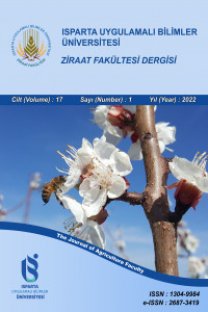Diyapoz Öncesi Beslemenin Bombus terrestris Ana Arılarının Diyapoz Sonrası Koloni Oluşturma Başarısı Üzerine Etkisi
Bombus arısı, Bombus terrestris, diyapoz öncesi besleme, koloni gelişimi
Effects of Pre-Diapause Feeding on Colony Foundation Success in Bombus terrestris Queens
Bumblebee, Bombus terrestris, pre-diapause feeding, colony development,
___
- Alaux, C., Savarit, F., Jaisson, P. and Hefetz, A. 2004. Does the Queen Win It All? Queen-Worker Conflict Over Male Production in the Bumble Bee, Bombus terrestris. Naturwissenchaften, 91: 400–403.
- Beekman, M., van Stratum, P. and Lingeman, R. 1998. Diapause Survival and Post Diapause Performance in Bumble Bee Queens. Entomologia Experimentalis et Applicata, 89: 207–214.
- Bloch, G. 1999. Regulation of Queen-Worker Conlict in Bumble Bee (Bombus terrestris) Colonies. Proceeding of Royal Society London B, 266: 2465–2469.
- Cameron, S.A., Hines, H.M. and Williams, P.H. 2007. A Comprehensive Phylogeny of the Bumblebees (Bombus). Biological Journal of Linnean Society, 91: 161–188.
- Cnaani, J., Robinson, G.E. and Hefetz, A. 2000. The Critical Period for Caste Determination in Bombus terrestris and Its Juvenile Hormone Correlates. Journal of Comperative Physiology A, 186: 1089–1094.
- Danks, H.V. 1987. Insect Dormancy: An Ecological Perspective. Biological Survey of Canada, Ottawa.
- Danks, H.V. 2000. Insect Cold Hardiness: A Canadian Perspective. Cryo Letters, 21: 297–308.
- Denlinger, D. L. 2008. Why Study Diapause? Entomological Research, 38: 1–9.
- Duchateau, M.J. and Velthuis, H.H.W. 1988. Development and Reproductive Strategies in Bombus terrestris Colonies. Behaviour, 107(3): 186–207.
- Duchateau, M.J., Velthuis, H.H.W. and Boomsma, J.J. 2004. Sex Ratio Variation in the Bumble Bee Bombus terrestris. Behavioral Ecology, 15: 71–82.
- Fliszkiewicz, M. and Wilkaniec, Z. 2007. Fatty Acids and Amino Acids in the Fat Body of Bumblebee Bombus terrestris (L.) in Diapausing and Non-Diapausing Queens. Journal of Apicultural Science, 51 (1): 55–63.
- Gösterit, A. ve Gürel, F. 2009. Effect of Different Diapause Regimes on Survival and Colony Development in the Bumble Bee, Bombus terrestris. Journal of Apicultural Research and Bee World, 48(4): 279–283.
- Gösterit, A. 2016. Adverse Effects of Inbreeding on Colony Foundation Success in Bumblebees, Bombus terrestris (Hymenoptera: Apidae). Applied Entomology and Zoology, 51(4): 521–526.
- Gösterit, A. ve Gürel, F. 2016. Male Remating and Its Influences on Queen Colony Foundation Success in the Bumblebee, Bombus terrestris. Apidologie, 47(6): 828–834.
- Gösterit, A., Koşkan, O. ve Gürel, F. 2016. The Relationship of Weight and Ovarian Development in Bombus terrestris L. Workers under Different Social Conditions. Journal of Apicultural Science, 60(2): 51–57.
- Gürel, F. ve Gösterit, A. 2008a. Effects of Different Starting Methods on Colony Initiation and Development of Bombus terrestris L. (Hymenoptera; Apidae) Queens. Applied Entomology and Zoology, 43(1): 113–-117.
- Gürel, F. ve Gösterit, A. 2008b. Effects of Temperature Treatments on the Bumblebee (Bombus terrestris L.) Colony Development. Akdeniz Üniversitesi Ziraat Fakültesi Dergisi, 21 (1): 75–78.
- Hahn, D.A. and Denlinger, D.L. 2007. Meeting the Energetic Demands of Insect Diapause: Nutrient Storage and Utilization. Journal of Insect Physiology, 53: 760–773.
- Hodek, I. 1996. Diapause Development, Diapause Termination and the End of Diapause. European Journal of Entomology, 93: 475–480.
- Kostal, V. 2006. Eco-physiological Phases of Insect Diapause. Journal of Insect Physiology, 52: 113–127.
- Kwon, Y.J., Saeed, S. and Duchateau, M.J. 2003. Stimulation of Colony Initiation and Colony Development in Bombus terrestris by Adding a Male Pupa: The Influence of Age and Orientation. Apidologie, 34: 429–437.
- Macevicz, S. and Oster, G. 1976. Modelling Social Insect Populations II: Optimal Reproductive Strategies in Annual Eusocial Insect Colonies. Behavioural Ecology and Sociobiology, 1: 265–282.
- Müller, C.B., Shykoff, J.A. and Sutcliffe, G.H. 1992. Life History Patterns and Opportinities for Queen-Worker Conflict in Bumblebees (Hymenoptera: Apidae). Oikos, 65: 242–248.
- Sağlam, Ş. ve Gösterit, A. 2015. Bombus Arısında (Bombus terrestris l.) Soya Unu ve Süt Tozu İçeren Polenin Yarayışlılığının Belirlenmesi. Süleyman Demirel Üniversitesi Ziraat Fakültesi Dergisi, 10(1): 90–96. Özbek, H. 2010. Arılar ve İnsektisitler. Uludağ Arıcılık Dergisi, 10 (3): 85–95.
- Velthuis, H.H.W. and van Doorn, A. 2006. A Century of Advances in Bumble Bee Domestication and the Economic and Environmental Aspects of Its Commercialization for Pollination. Apidologie, 37: 421–451.
- Williams, P.H. 1998. An Annotated Checklist of Bumble Bees with an Analysis of Patterns of Description (Hymenoptera: Apidae, Bombini). Bulletin of the Natural History Museum, Entomology Series, 67(1): 79–152.
- Yeninar, H., Duchateau, M.J., Kaftanoğlu, O. ve Velthuis, H., 2000. Colony Developmental Patterns in Different Local Populations of the Turkish Bumble Bee, Bombus terrestris dalmatinus. Journal of Apicultural Research, 39: 107–116.
- ISSN: 1304-9984
- Yayın Aralığı: Yılda 2 Sayı
- Başlangıç: 2006
- Yayıncı: Isparta Uygulamalı Bilimler Üniversitesi
Yağ Gülünün (Rosa damascena Mill.) Bitki Su Tüketimi Tahmininde Kullanılabilecek Amprik Modeller
YUSUF UÇAR, SONER KAZAZ, FİGEN ERASLAN İNAL, HASAN BAYDAR
ABDULLAH NURİ ÖZSOY, Davut UYSAL, Selami GÖKGÖL
Özlem SEFER, EMRE YÖRÜK, Elif Sedef DEVELİ, Işıl Melis ZÜMRÜT, Ayşe Server SEZER, Zeynep KONUKÇU
HAYATİ KÖKNAROĞLU, Vecdi DEMİRCAN, Hasan YILMAZ, Zeynep DERNEK
Bazı Kışlık Buğday Çeşitlerinin Erken Fide Dönemindeki Gelişimleri
Bıldırcınların Yumurta Verimi Özelliklerinde Kanonik Korelasyon Analizi
ÇİĞDEM TAKMA, YAKUT GEVREKÇİ, ABDULLAH NURİ ÖZSOY, MUZAFFER ÇEVİK
Sürdürülebilir Tarımda Birlikte Yetiştiricilik
Türkiye’deki Buğday Veriminin Karşılaştırılması: Hatay ve Şanlıurfa İlleri Örneği
MURAT TİRYAKİOĞLU, BEKİR DEMİRTAŞ, HALİT TUTAR
Burdur-Hacılar Köyü Taban Merasında Verim ve Kalite Üzerine Gübrelemenin Etkileri
